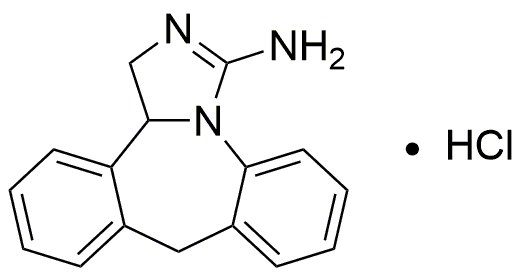Epinastine hydrochloride is widely utilized in research focused on:
- Allergy Treatment: This compound is primarily used in the formulation of antihistamines, providing relief from allergic symptoms such as sneezing, itching, and runny nose.
- Ophthalmic Solutions: It is commonly found in eye drops for treating allergic conjunctivitis, helping to alleviate eye irritation and redness effectively.
- Clinical Research: Epinastine hydrochloride is a subject of various studies aimed at understanding its efficacy and safety in treating allergic reactions, contributing to advancements in allergy management.
- Pharmaceutical Development: The compound serves as a model for developing new antihistamines, allowing researchers to explore modifications that enhance therapeutic effects or reduce side effects.
- Comparative Studies: It is often used in comparative studies with other antihistamines, helping to identify its advantages, such as a lower sedation effect, making it suitable for daytime use.
Informations générales
Propriétés
Sécurité et réglementation
Applications
Epinastine hydrochloride is widely utilized in research focused on:
- Allergy Treatment: This compound is primarily used in the formulation of antihistamines, providing relief from allergic symptoms such as sneezing, itching, and runny nose.
- Ophthalmic Solutions: It is commonly found in eye drops for treating allergic conjunctivitis, helping to alleviate eye irritation and redness effectively.
- Clinical Research: Epinastine hydrochloride is a subject of various studies aimed at understanding its efficacy and safety in treating allergic reactions, contributing to advancements in allergy management.
- Pharmaceutical Development: The compound serves as a model for developing new antihistamines, allowing researchers to explore modifications that enhance therapeutic effects or reduce side effects.
- Comparative Studies: It is often used in comparative studies with other antihistamines, helping to identify its advantages, such as a lower sedation effect, making it suitable for daytime use.
Documents
Fiches de données de sécurité (FDS)
La FDS fournit des informations de sécurité complètes sur la manipulation, le stockage et l’élimination du produit.
Spécifications du produit (PS)
Le PS fournit une description complète des propriétés du produit, notamment sa composition chimique, son état physique, sa pureté et les exigences de stockage. Il détaille également les plages de qualité acceptables et les applications prévues du produit.
Certificats d'analyse (COA)
Recherchez des certificats d'analyse (COA) en saisissant le numéro de lot du produit. Les numéros de lot et de lot se trouvent sur l'étiquette d'un produit, après les mots « Lot » ou « Lot de fabrication ».
Numéro de catalogue
Numéro de lot/série
Certificats d'origine (COO)
Ce certificat d'exploitation confirme le pays dans lequel le produit a été fabriqué, et détaille également les matériaux et composants utilisés et s'il est issu de sources naturelles, synthétiques ou autres sources spécifiques. Ce certificat peut être requis pour les douanes, le commerce et la conformité réglementaire.
Numéro de catalogue
Numéro de lot/série
Fiches de données de sécurité (FDS)
La FDS fournit des informations de sécurité complètes sur la manipulation, le stockage et l’élimination du produit.
DownloadSpécifications du produit (PS)
Le PS fournit une description complète des propriétés du produit, notamment sa composition chimique, son état physique, sa pureté et les exigences de stockage. Il détaille également les plages de qualité acceptables et les applications prévues du produit.
DownloadCertificats d'analyse (COA)
Recherchez des certificats d'analyse (COA) en saisissant le numéro de lot du produit. Les numéros de lot et de lot se trouvent sur l'étiquette d'un produit, après les mots « Lot » ou « Lot de fabrication ».
Numéro de catalogue
Numéro de lot/série
Certificats d'origine (COO)
Ce certificat d'exploitation confirme le pays dans lequel le produit a été fabriqué, et détaille également les matériaux et composants utilisés et s'il est issu de sources naturelles, synthétiques ou autres sources spécifiques. Ce certificat peut être requis pour les douanes, le commerce et la conformité réglementaire.


